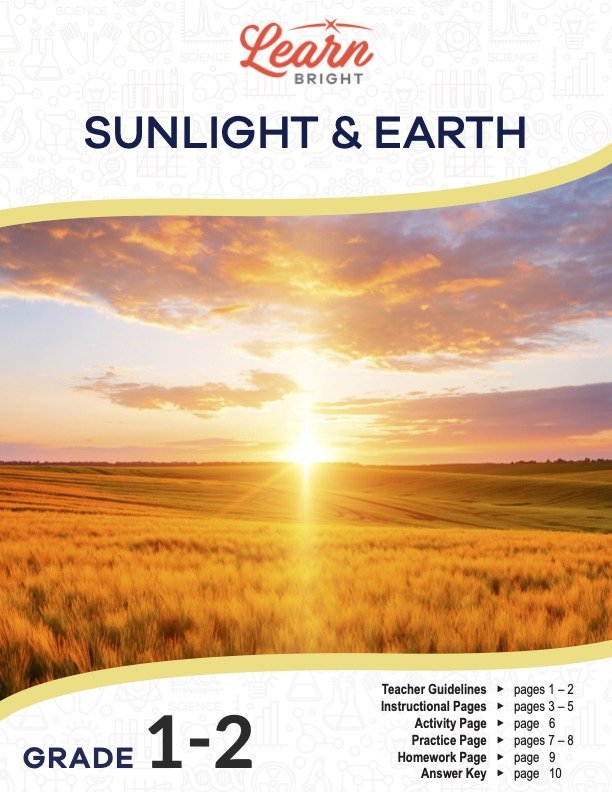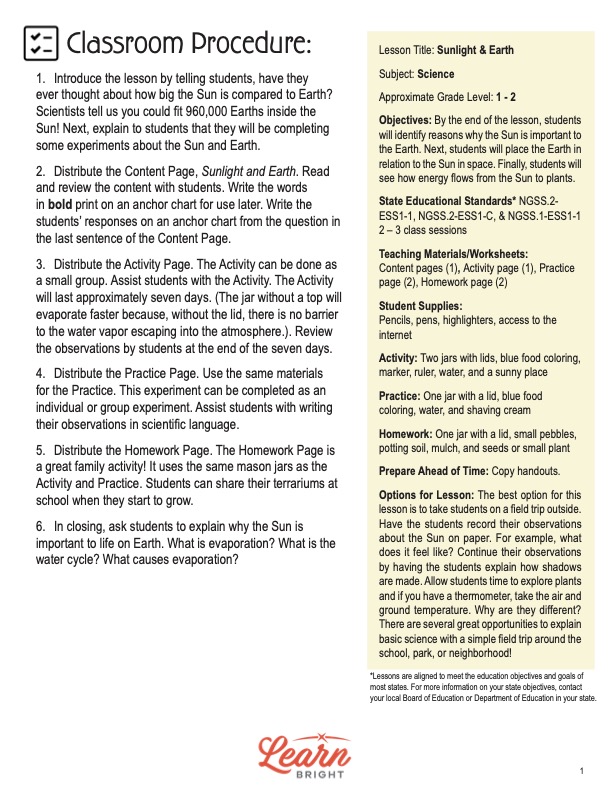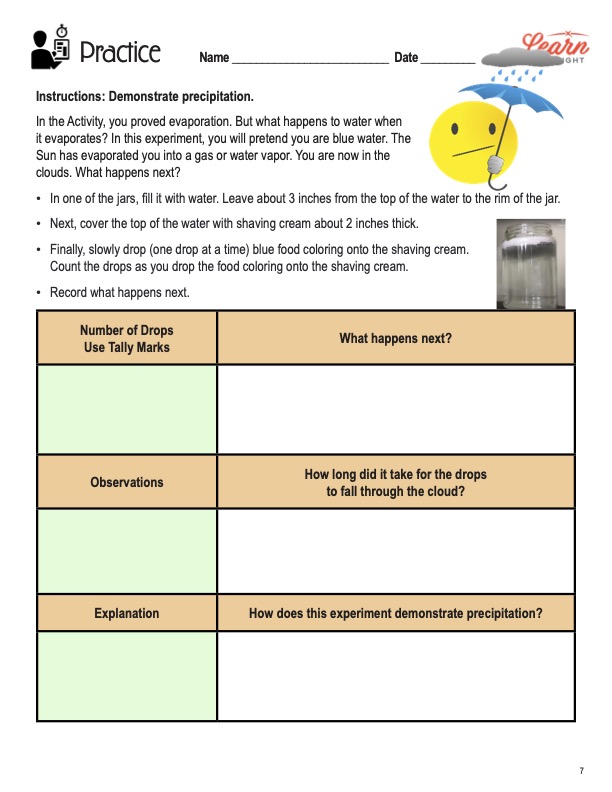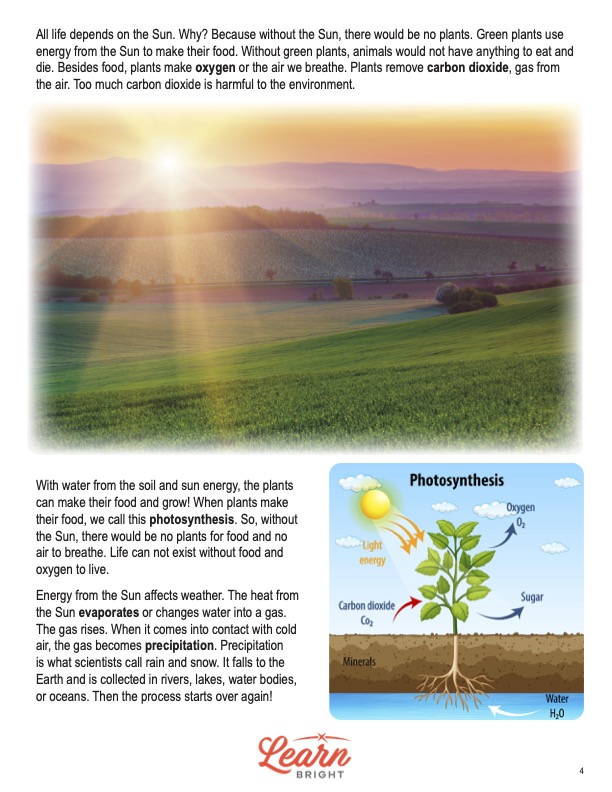Description
What our Sunlight and Earth lesson plan includes
Lesson Objectives and Overview: Sunlight and Earth teaches students about many of the ways that the sun benefits our planet. Students will learn that, in addition to providing light and heat, the sun provides energy, vitamin D, and precipitation. They will also discover a little about the process of photosynthesis. This lesson is for students in 1st grade, 2nd grade, and 3rd grade.
Classroom Procedure
Every lesson plan provides you with a classroom procedure page that outlines a step-by-step guide to follow. You do not have to follow the guide exactly. The guide helps you organize the lesson and details when to hand out worksheets. It also lists information in the yellow box that you might find useful. You will find the lesson objectives, state standards, and number of class sessions the lesson should take to complete in this area. In addition, it describes the supplies you will need as well as what and how you need to prepare beforehand. This lesson requires only colored pencils in addition to the worksheets.
Options for Lesson
The “Options for Lesson” section provides several suggestions for additional activities or alternative ways to go about parts of the lesson. Regarding the activity, one suggestion is to let students work in pairs but still use their own worksheet page. Another suggestion is to present the lesson outside rather than in the classroom. You could also expand on the process of photosynthesis when you start discussing it during the lesson. Another option is to elaborate on the benefits of solar energy and how it helps the environment. One more idea is to let students draw their own rendition of the five reasons that the sun is so important, as an additional activity.
Teacher Notes
The paragraph on this page provides a little extra information on what you can expect from the lesson. It suggests you teach the lesson outside on a sunny day so that students can benefit from a truly hands-on experience. You could also teach this lesson at the same time as or before a lesson photosynthesis. Use the lines to write out your thoughts as you prepare.
SUNLIGHT AND EARTH LESSON PLAN CONTENT PAGES
Energy, Heat, and Precipitation
The Sunlight and Earth lesson plan contains two pages of content. The first page begins with a statement about the sun. Everyone knows that the bright yellow circle in the sky is the sun. At any given time, it shines its light somewhere in the world. Students may not realize that the sun does more than just provide light throughout the world. In fact, there are several reasons why the sun is so important for the earth. In fact, it is vital to the survival of all living things.
Ultimately, the sun is the source of all food. This is because of the process of photosynthesis. Plants use sunlight in that process to make their own food using the sun’s energy. Without this source of energy, plants would not be able to make food. If plants cannot make food, they will die, so the animals that eat plants for their survival would likewise die. All the other animals would have nothing to eat, including people. Equally important is the fact that plants release oxygen into the atmosphere so that we can breathe. In the end, life on Earth would cease to exist without the energy from the sun.
The sun’s light is not the only thing keeping our planet alive. Heat is equally important to the survival of life, and we would not exist without it. Other planets receive heat from the sun, but there is too much or too little to support living things. The sun warms the earth’s surface, which in turn transmits heat to the air above it. Due to the earth’s movements, the heat does not distribute evenly. Despite this, however, life can exist in nearly every part of the world.
As surprising as it may sound, the earth would receive no precipitation without the sun. This is because the sun evaporates water from oceans, rivers, lakes, and other bodies of water on the earth’s surface. The water turns into moist air in the atmosphere, and temperature affects that moist air. The moisture returns to the earth in the form of rain, snow, and other precipitation. Without the sun, the whole earth would become like a desert and suffer from droughts.
Vitamin D, Light, and Energy
The lesson explains that another great reason to appreciate the sun is its gift of vitamin D. The human body can make its own vitamin D using sunlight that the skin absorbs. This vitamin is extremely important for strong and healthy bones. In addition, it helps other parts of the body work well and fight infections.
Going back to light, why is it so important to have light from the sun? Light is often the benefit people most enjoy when it comes to the sun. After all, it allows us to see! With sunlight, we can build homes, plant gardens, play games, read at a beach, and enjoy so many more things about life. People often feel happier because of the sun’s light as well. Students will learn that light from the sun takes about eight minutes to reach the earth.
One more incredible benefit that the sun bestows upon the earth is solar energy. Solar energy turns energy from the sun into electricity to power homes and businesses. This type of energy is better for the environment and costs less than others overall to maintain. The earth benefits from many advantages because of the sun and its light. Exposure to the sun without proper protection, however, can be dangerous and cause various issues.
SUNLIGHT AND EARTH LESSON PLAN WORKSHEETS
The Sunlight and Earth lesson plan includes three worksheets: an activity worksheet, a practice worksheet, and a homework assignment. Each one of these handouts will help students demonstrate their knowledge and will reinforce what they learned throughout the lesson. Use the guidelines on the classroom procedure page to determine when to give students each worksheet.
PROVING EVAPORATION ACTIVITY WORKSHEET
The activity requires students to to prove that evaporation really does occur. First, they will fill two jars with water, leaving about two inches from the top of the jar. They will drop food coloring in the water until it is blue. Then they will mark the jars to show the water levels and place the lid on just one of the jars. They will leave the other one without a cover.
Students will place their jars in a sunny spot and check on the water levels each day for a week. They will mark the jars every day to show the new water levels and record all this information in the chart on the worksheet page. After a week, they will answer which jar had the most evaporation and why.
PRECIPITATION PRACTICE WORKSHEET
For the practice worksheet, students will conduct another experiment that involves precipitation. Students will fill one of two jars with water, leaving three inches from the rim of the jar to the top of the water level. Next, they will cover the top of the water with shaving cream about two inches thick.
Students will slowly add drops of blue food coloring one at a time onto the shaving cream. They must count the drops as they go in and record what happens as they do so in the table on the worksheet page.
SUNLIGHT AND EARTH HOMEWORK ASSIGNMENT
Students will get to create a mini planet for the homework assignment. They will fill a glass jar with small pebbles, a layer of mulch or potting soil mix. Next they will add just potting soil and seeds if they have some. If they choose to add seeds, they should put a little more potting soil on top of them. If they use a small plant, they should be sure to cover the roots with soil and make a small indentation around the plant.
Next, students will add another layer of mulch or potting soil mix and a small amount of water. After screwing on the lid, they will place the jar somewhere where there is indirect sunlight. In a few days, they should notice water on the sides of the jar. They will explain this in the prompt at the bottom of the page. Finally, they will explain how the jar is like the earth and sun.
Worksheet Answer Keys
The last few pages of the lesson plan document are answer keys for the practice and homework worksheets. All the correct answers are in red to make it easy to compare them with students’ work. There may be some variation on the practice worksheet, but students’ responses should roughly reflect those on the answer keys. If you choose to administer the lesson pages to your students via PDF, you will need to save a new file that omits these pages. Otherwise, you can simply print out the applicable pages and keep these as reference for yourself when grading assignments.









